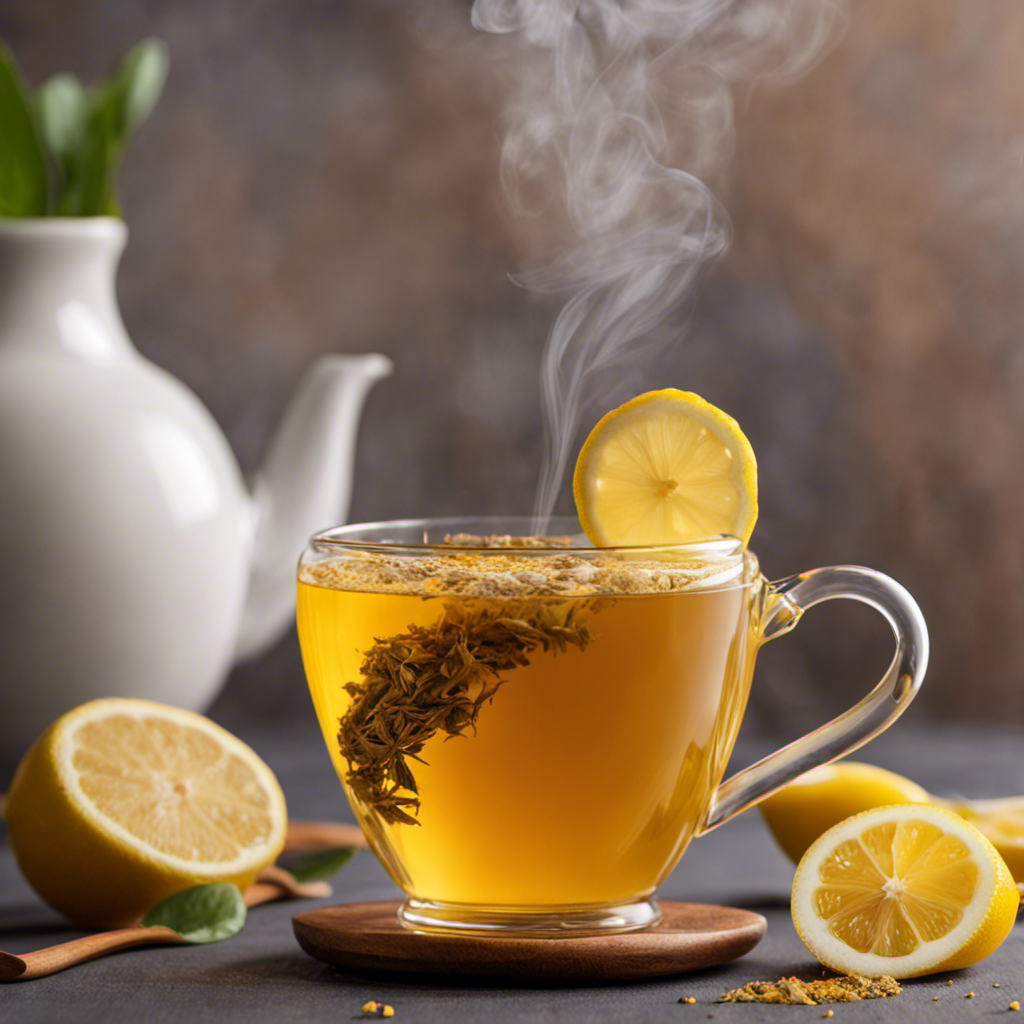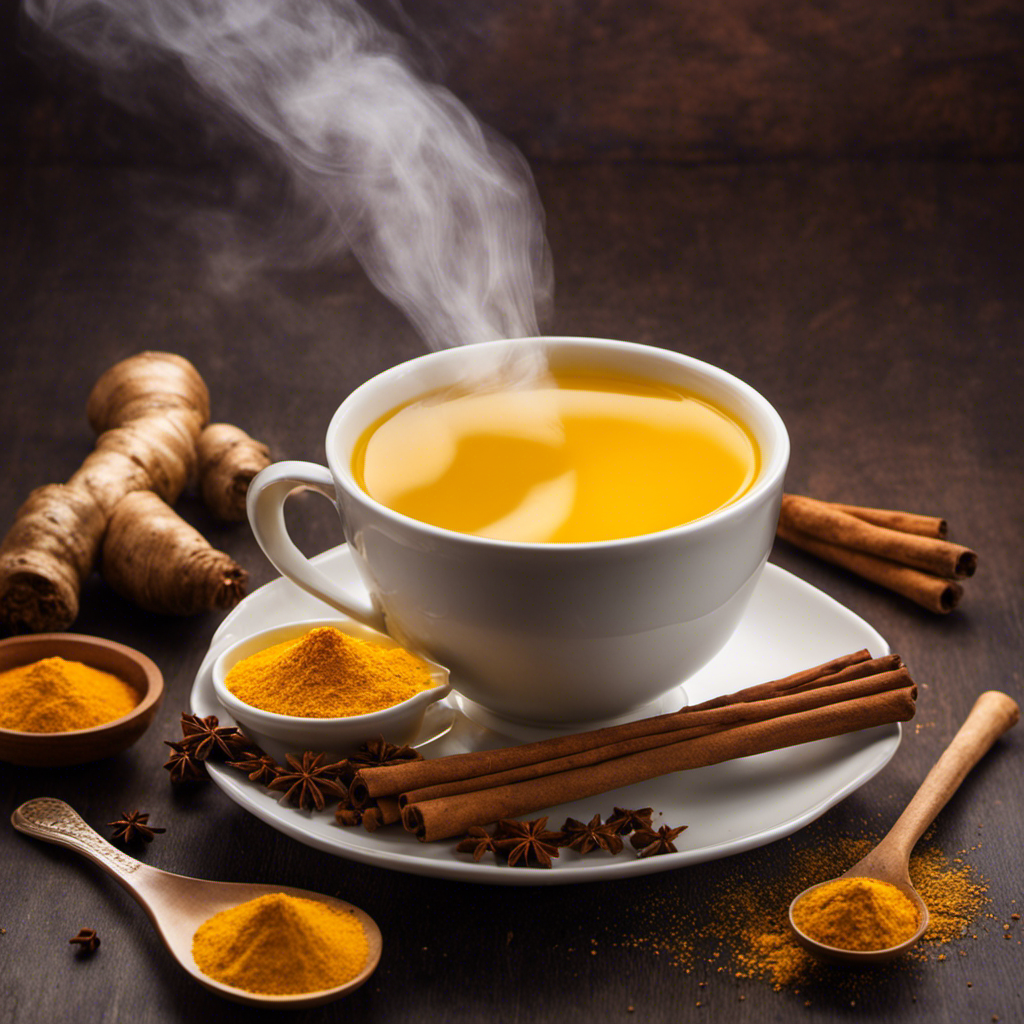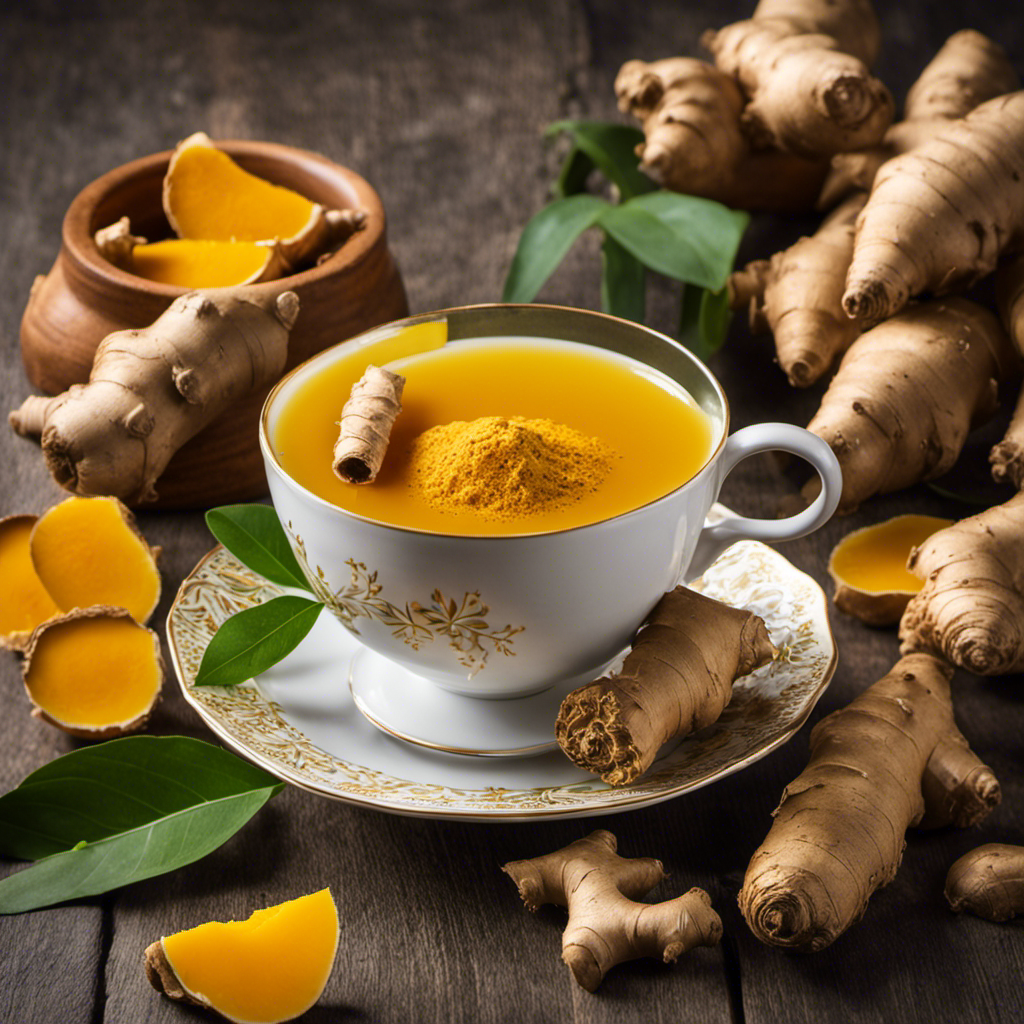Matcha
Matcha’s Boost: Does Matcha Give Energy & Vitality?

Do you ever feel like you need an energy boost that can take you from feeling sluggish to supercharged? Well, let me tell you, matcha is here to save the day!
If you’re looking for a natural way to revitalize your body and mind, matcha might just be the answer you’ve been searching for. In this article, we’ll explore the energizing properties of matcha and how it can help you serve others to the best of your ability.
From its unique composition to the synergy between caffeine and L-Theanine, we’ll uncover the secrets behind matcha’s ability to enhance alertness, focus, and overall vitality.
So, get ready to discover the power of matcha and how you can incorporate it into your daily routine for a sustainable energy boost.
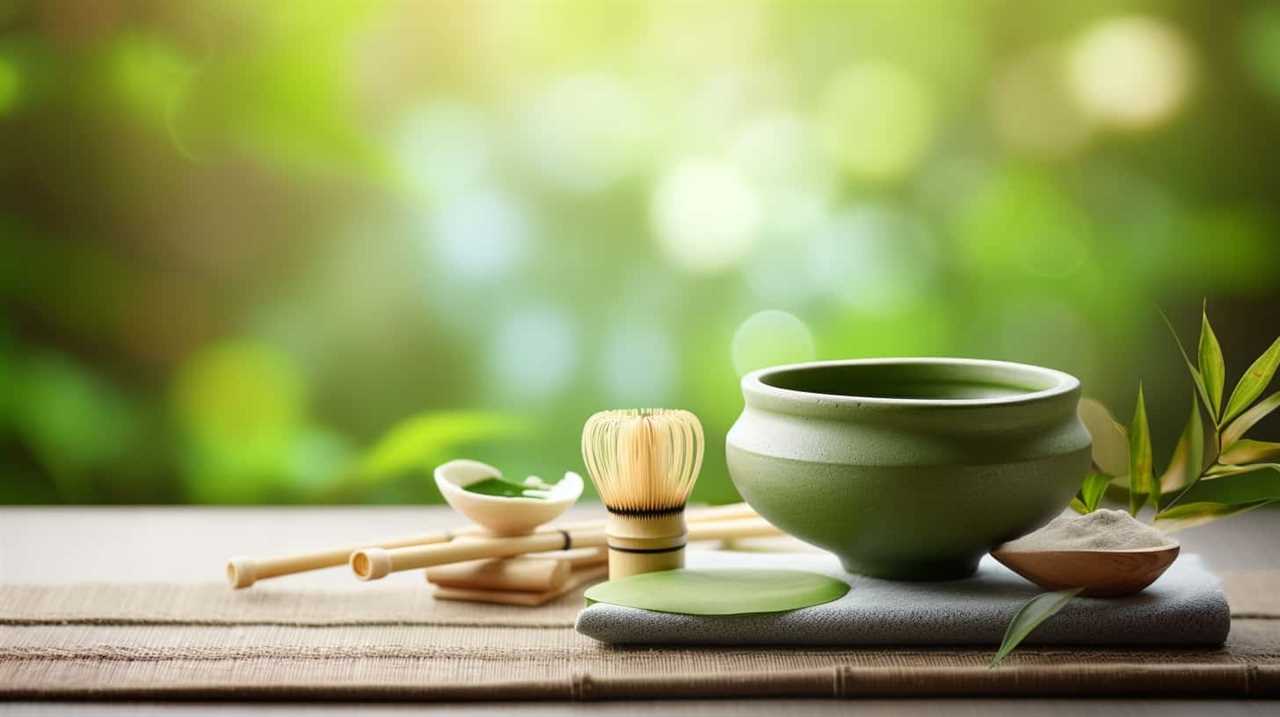
Key Takeaways
- Matcha provides a sustained and gentle energy boost without jitters or crashes.
- The combination of L-theanine and caffeine in matcha enhances mental focus and concentration.
- Matcha promotes relaxation, reduces stress, and improves cognitive function.
- Matcha boosts physical performance, energy levels, and endurance, while also providing antioxidant benefits.
The Origins of Matcha
Matcha originated in Japan during the 12th century and has since become a popular beverage worldwide. The origins of matcha can be traced back to the Zen Buddhist monks who discovered its unique qualities. They cultivated the tea plants in shaded areas to enhance the flavor and increase the chlorophyll content in the leaves. This process, known as ‘shading,’ is one of the cultivation techniques that distinguish matcha from other types of tea.
The monks carefully hand-picked the leaves, steamed them, and then ground them into a fine powder using traditional stone mills. This labor-intensive process ensured that the tea leaves retained their vibrant green color and nutrient-rich composition.
Matcha cultivation has evolved over time, with advancements in technology and farming techniques. Today, matcha is produced in various regions of Japan, each with its own distinct flavor profile and cultivation practices. The careful cultivation techniques employed by farmers contribute to the unique taste and quality of matcha.
In the subsequent section, we’ll explore the composition of matcha and how it contributes to its health benefits and energizing effects.

The Composition of Matcha
After exploring the origins of matcha and its cultivation techniques, we can now delve into the composition of this vibrant green tea powder. Matcha is known for its high concentration of antioxidants and amino acids, which contribute to its numerous health benefits.
One of the key components of matcha is its antioxidants. Matcha contains a class of antioxidants called catechins, which are known for their ability to fight free radicals in the body. Free radicals are unstable molecules that can cause damage to cells and contribute to aging and disease. By consuming matcha, we can help protect our bodies from these harmful effects.
In addition to antioxidants, matcha is also rich in amino acids. One particular amino acid found in matcha is L-theanine. L-theanine has been shown to promote relaxation and reduce stress levels. It also has the unique ability to enhance focus and concentration without causing drowsiness. This makes matcha a great choice for those looking for a natural way to boost their energy and improve cognitive function.
The composition of matcha is also influenced by its processing methods. Matcha leaves are steamed and then ground into a fine powder. This process helps to preserve the nutrients and antioxidants present in the leaves, making matcha a potent source of health-promoting compounds.
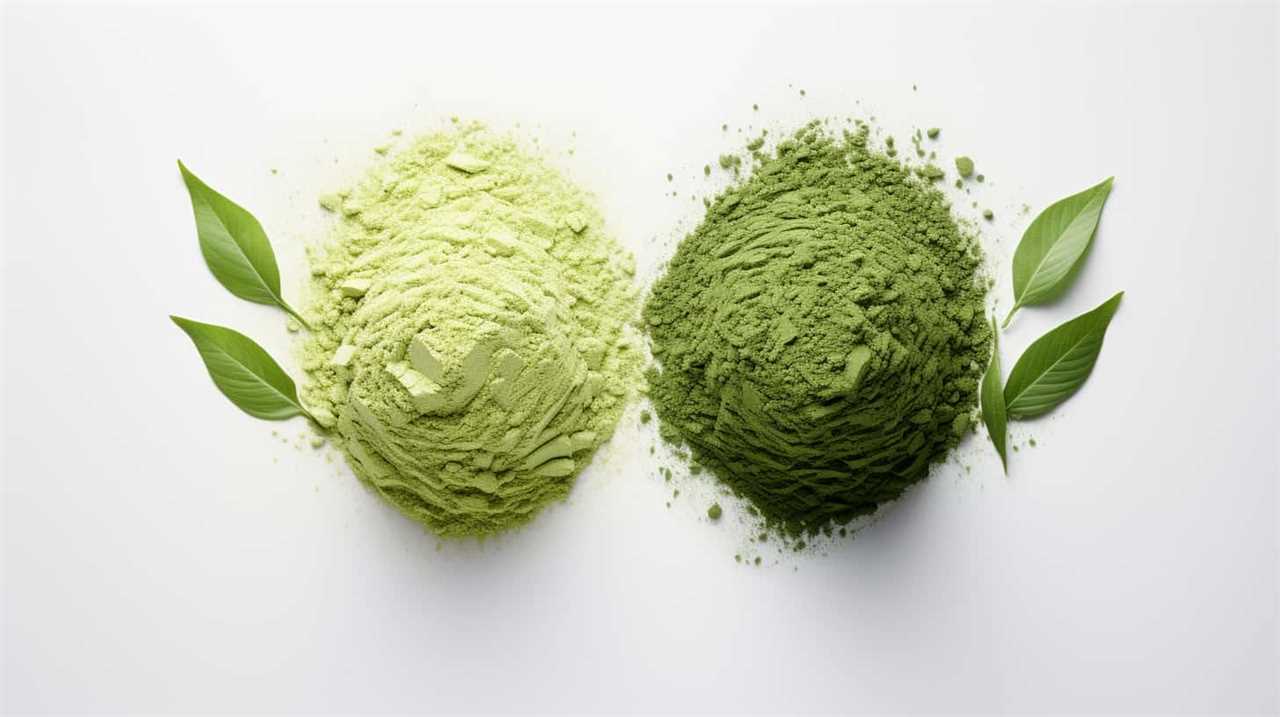
Caffeine Content in Matcha
When it comes to caffeine content, matcha and coffee have different levels.
While a cup of coffee typically contains around 95 mg of caffeine, a cup of matcha has about 35 mg.
However, what sets matcha apart is the way caffeine is absorbed in the body, providing a more sustained and gentle energy boost without the jitters or crash associated with coffee.
Additionally, matcha offers a range of health benefits, including antioxidants and amino acids, making it a healthier alternative to coffee for those looking to boost their energy levels.
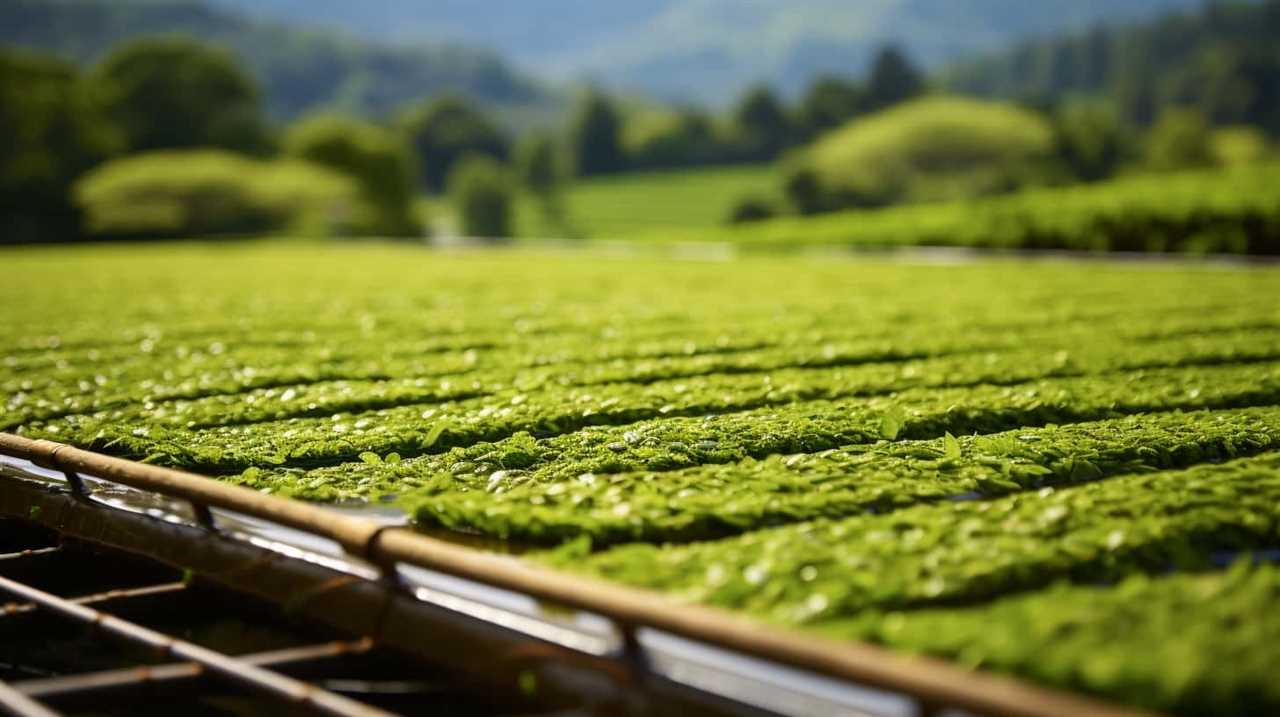
Matcha Vs. Coffee
We found that the caffeine content in matcha is comparable to that of coffee. While many people rely on coffee for a quick energy boost, matcha can be a healthier alternative. Matcha provides a sustained energy boost without the jitters or crash that can come with coffee consumption.
Here is a comparison of the caffeine content in matcha and coffee:
| Matcha | Coffee |
|---|---|
| 35mg | 95mg |
As you can see, matcha contains about one-third of the caffeine found in coffee. This makes matcha a great choice for those looking to reduce their caffeine intake or for individuals who are more sensitive to the effects of caffeine. Additionally, matcha provides a host of other benefits such as being rich in antioxidants, boosting metabolism, and promoting relaxation. So, next time you need a pick-me-up, consider reaching for a cup of matcha instead of coffee.
Caffeine Absorption in Body
To understand how matcha gives energy, it’s important to consider the caffeine absorption in the body and the specific caffeine content in matcha. Here are four key points to consider:
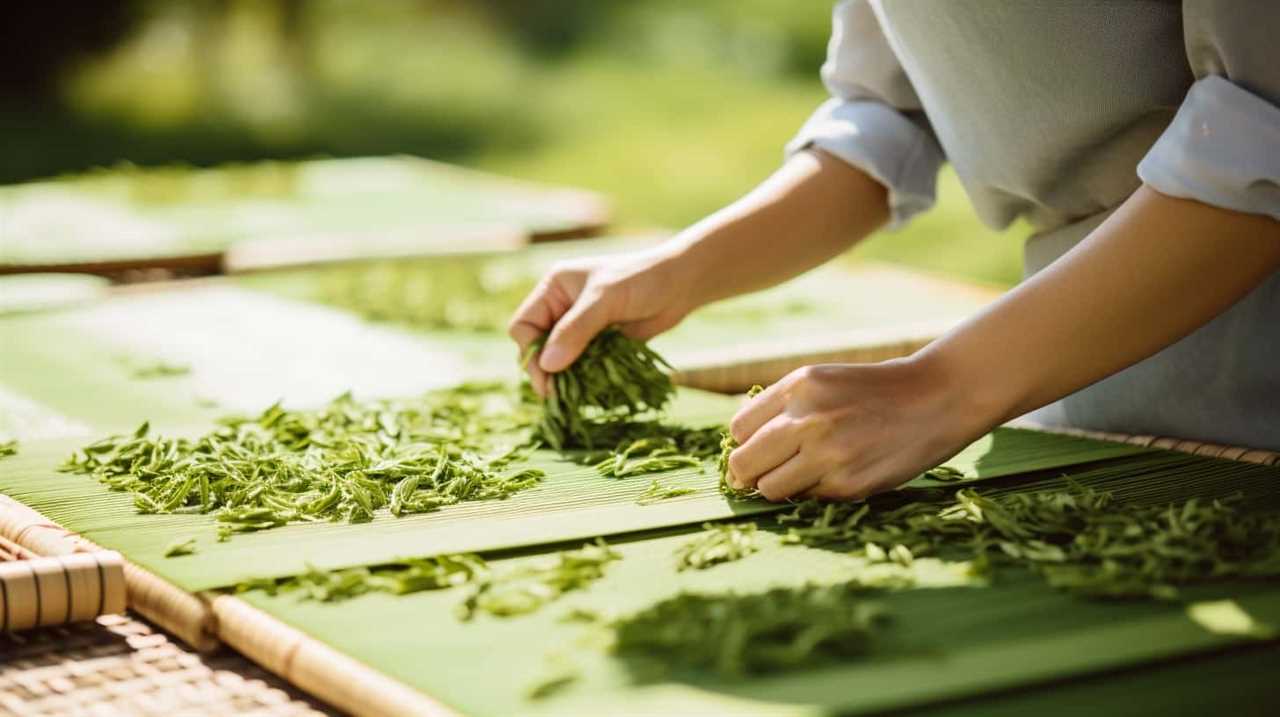
- Caffeine Absorption Rate:
The caffeine in matcha is absorbed more slowly by the body compared to coffee. This slower release provides a sustained energy boost without the sudden crash that can occur with other caffeinated beverages. - Caffeine Content in Matcha:
Matcha contains about 35 milligrams of caffeine per serving, which is lower than the caffeine content in coffee but higher than that in green tea. This moderate amount of caffeine helps to promote alertness and focus. - Effects of Caffeine on the Body:
Caffeine stimulates the central nervous system, increasing alertness and reducing fatigue. It also enhances cognitive function and improves mood. - Serving Others:
Health Benefits of Matcha
The caffeine content in matcha contributes to its health benefits, including increased alertness and focus. Matcha contains a moderate amount of caffeine, which can provide a gentle and sustained energy boost without the jitters or crash often associated with coffee. Additionally, matcha is rich in antioxidants, which can help protect the body against oxidative stress and promote overall health. These antioxidants, such as catechins, have been linked to a variety of health benefits, including reduced risk of chronic diseases and improved cardiovascular health. Furthermore, matcha has been studied for its potential role in weight management. Its combination of caffeine and antioxidants may help increase metabolism and fat oxidation, leading to enhanced weight loss. Overall, incorporating matcha into your daily routine can provide numerous health benefits, making it a great choice for those looking to improve their well-being.
| Benefit | Description |
|---|---|
| Increased Alertness | Matcha’s caffeine content helps improve focus and mental clarity, providing an energy boost without the jitters or crash. |
| Antioxidant Benefits | Matcha is rich in antioxidants, such as catechins, which can protect against oxidative stress and promote overall health. |
| Reduced Risk of Diseases | The antioxidants in matcha have been linked to a lower risk of chronic diseases, including heart disease, cancer, and neurodegenerative disorders. |
| Improved Cardiovascular Health | Matcha’s catechins may help lower blood pressure and cholesterol levels, leading to improved heart health. |
| Role in Weight Management | Matcha’s combination of caffeine and antioxidants may help increase metabolism and fat oxidation, aiding in weight loss efforts. |
Matcha and L-Theanine Synergy
How does the synergy between Matcha and L-Theanine contribute to increased energy levels?
Matcha, a powdered form of green tea, contains L-Theanine, an amino acid that has been found to have various health benefits. When consumed together, Matcha and L-Theanine work synergistically to provide increased energy levels. Here’s how:
- Matcha and relaxation: Matcha is known for its ability to induce a state of calmness and relaxation. This is attributed to the high concentration of L-Theanine present in Matcha, which promotes the production of alpha brain waves, leading to a relaxed but alert mental state.
- Matcha and stress relief: L-Theanine in Matcha has been shown to reduce stress and anxiety levels by increasing the production of serotonin and dopamine, neurotransmitters responsible for regulating mood and emotions.
- Enhanced focus and attention: The combination of Matcha and L-Theanine promotes improved cognitive function, including enhanced focus and attention. L-Theanine increases the production of alpha brain waves, which are associated with improved mental clarity and concentration.
- Sustained energy without jitters: Unlike other sources of caffeine, Matcha provides a sustained release of energy without the jitters or energy crashes. This is because L-Theanine in Matcha slows down the absorption of caffeine, resulting in a more gradual and prolonged release of energy.
The synergy between Matcha and L-Theanine contributes to increased energy levels by promoting relaxation, reducing stress, enhancing focus, and providing sustained energy. Now, let’s explore how Matcha can also boost alertness.
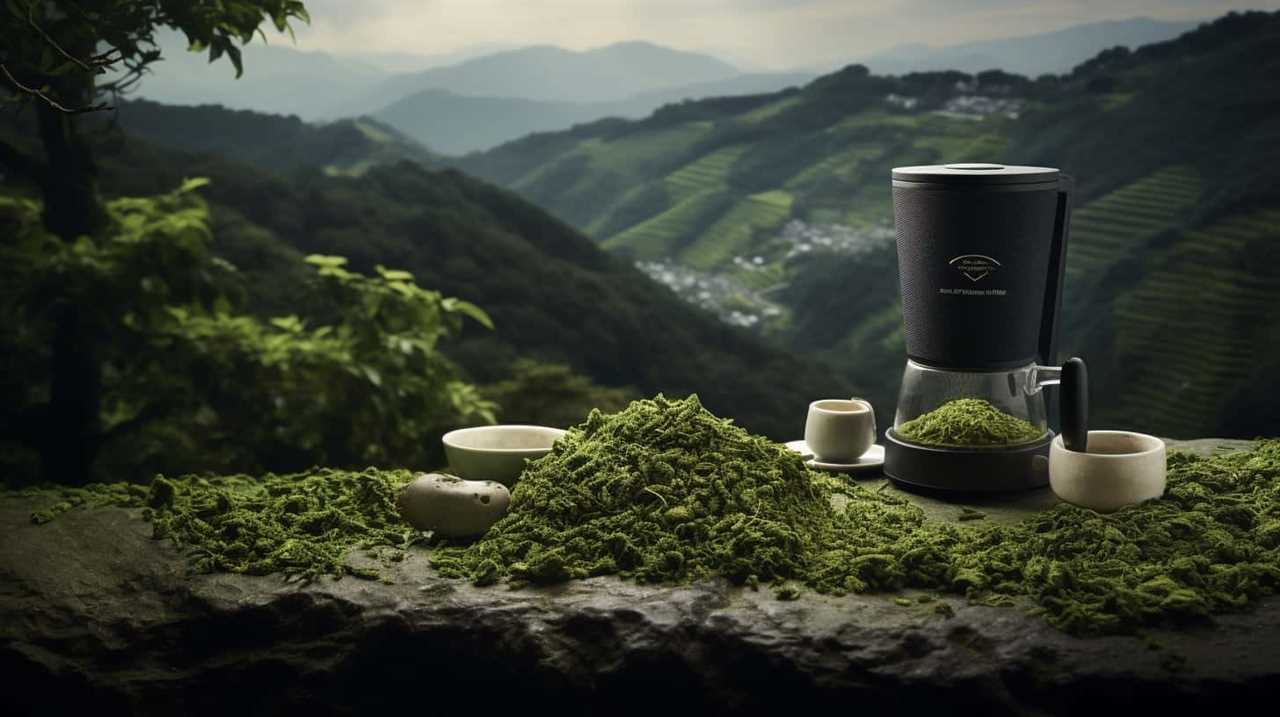
Matcha and Alertness
When it comes to the battle of Matcha vs. coffee, Matcha emerges as the victor when it comes to alertness.
While coffee may provide a quick jolt of energy, Matcha offers a sustained boost without the jitters or crash.
The combination of caffeine and L-Theanine in Matcha promotes mental focus and clarity, leading to increased productivity throughout the day.
Matcha Vs. Coffee
Our experience with matcha and coffee has shown that matcha’s impact on alertness is worth considering.

When comparing matcha to coffee, there are a few key differences to note:
- Sustained energy: While coffee provides a quick burst of energy, matcha offers a more sustained boost without the jitters or crash commonly associated with coffee.
- Antioxidant content: Matcha contains higher levels of antioxidants compared to coffee, making it a healthier choice for overall well-being.
- L-theanine effect: Matcha contains L-theanine, an amino acid that promotes relaxation and focus. This combination with caffeine provides a calming alertness, unlike the jittery feeling often experienced with coffee.
- Matcha vs. energy drinks and herbal tea: Unlike energy drinks that are loaded with sugar and artificial ingredients, matcha offers a natural and healthier alternative. Additionally, matcha provides more caffeine than herbal tea, making it a better choice for those seeking an energy boost.
Matcha and Mental Focus
After experiencing the sustained energy and calming alertness provided by matcha, we began to explore its impact on mental focus and alertness. Matcha has been found to have positive effects on cognitive performance and concentration. The high concentration of L-theanine, an amino acid found in matcha, is believed to be responsible for these benefits.
L-theanine promotes relaxation without causing drowsiness, which can help improve focus and attention. Additionally, matcha contains caffeine, which can enhance alertness and increase mental clarity. Studies have shown that the combination of L-theanine and caffeine in matcha can improve cognitive function and attention span.
Matcha and Productivity
We found that matcha significantly enhances our alertness and productivity. Here are four ways in which matcha can boost your productivity:

- Improved focus: Matcha contains L-theanine, an amino acid that promotes relaxation without drowsiness. This helps to calm the mind and enhance concentration, allowing you to stay focused on tasks for longer periods of time.
- Increased energy levels: Matcha contains caffeine, which provides a natural and sustained energy boost. Unlike coffee, matcha releases caffeine slowly, giving you a steady and prolonged energy throughout the day.
- Enhanced time management: Matcha can help you manage your time more effectively by improving your mental clarity and reducing distractions. With increased focus and energy, you’ll be able to prioritize tasks and accomplish them more efficiently.
- Boosted creativity: Matcha stimulates the brain and promotes alpha wave activity, which is associated with creativity and problem-solving. It can help you think outside the box and come up with innovative solutions to challenges.
Matcha and Focus
Using the energizing properties of matcha, we find that it enhances focus and concentration. Matcha has been shown to have a positive impact on cognitive performance, making it a valuable tool for those seeking to improve their ability to concentrate. The high levels of L-theanine found in matcha work synergistically with caffeine to promote mental alertness and clarity, without the jitters or crash commonly associated with caffeine consumption.
Studies have shown that the combination of L-theanine and caffeine in matcha can improve attention and reaction time, as well as enhance working memory and cognitive function. This is because L-theanine increases alpha brain waves, which are associated with a state of relaxed alertness and focus. Additionally, matcha contains antioxidants that can help protect brain cells from oxidative damage, further supporting cognitive health.
Incorporating matcha into your daily routine can be a simple and effective way to enhance your focus and concentration. Whether you choose to enjoy a cup of matcha in the morning or as an afternoon pick-me-up, its energizing properties and cognitive benefits can help you stay focused and productive throughout the day.
Matcha and Overall Vitality
To boost overall vitality, consuming matcha can provide us with a number of energizing benefits. Matcha isn’t only a delicious and refreshing beverage but also a great addition to any wellness routine. Here’s how matcha can help improve your vitality:
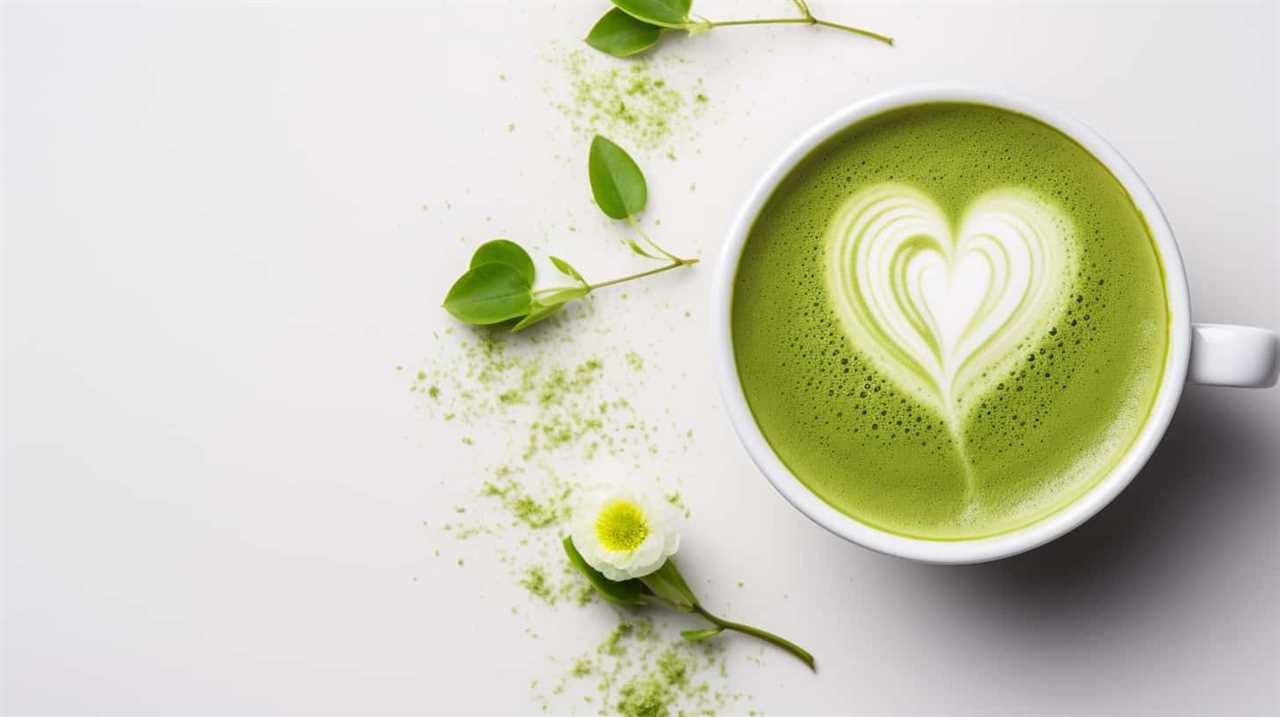
- Matcha and Exercise:
Matcha contains a unique combination of caffeine and amino acids that can enhance physical performance. It boosts energy levels, improves endurance, and helps you stay focused during workouts. Whether you’re hitting the gym or going for a run, a cup of matcha can give you the extra energy you need to power through your exercise routine. - Matcha and Stress Relief:
Matcha is rich in L-theanine, an amino acid known for its calming properties. It promotes relaxation, reduces stress, and helps improve mood. Consuming matcha can help you unwind after a long day and restore your vitality by reducing stress levels. - Antioxidant Powerhouse:
Matcha is packed with antioxidants called catechins, which help protect our cells from damage caused by free radicals. By reducing oxidative stress, matcha can support overall vitality and well-being. - Nutrient-Rich Superfood:
Matcha is a true powerhouse when it comes to nutrients. It’s rich in vitamins, minerals, and fiber, which are essential for maintaining good health and vitality.
Incorporating matcha into your daily routine can provide you with the energy and vitality you need to live life to the fullest. So why not give matcha a try and experience its amazing benefits for yourself?
How to Incorporate Matcha for Energy Boost
To maximize the energizing benefits of matcha, incorporating it into our daily routine can provide us with the sustained energy boost we need.
There are several ways to incorporate matcha into our diet, allowing us to enjoy its benefits in delicious and creative ways. One popular option is to make matcha recipes, such as matcha smoothies or matcha lattes. These recipes not only provide us with a refreshing and energizing drink but also allow for experimentation with different flavors and ingredients.
Another way to incorporate matcha is by using it as an ingredient in baking. Matcha can be added to cookies, cakes, and even muffins, giving these treats a vibrant green color and a subtle, earthy flavor.
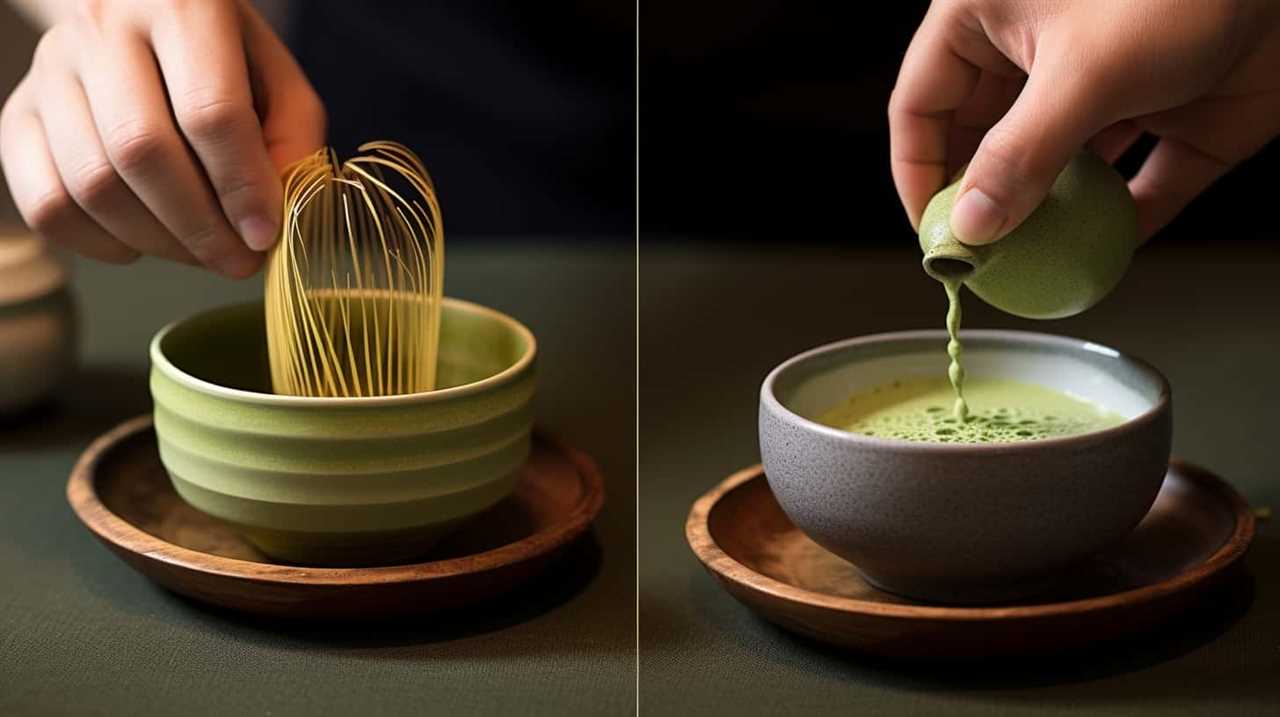
When it comes to using matcha for weight loss, incorporating it into a healthy and balanced diet is key. Matcha is known to boost metabolism and increase fat burning, making it a great addition to a weight loss plan. However, it’s important to note that matcha alone won’t lead to significant weight loss. It should be combined with regular exercise and a nutritious diet for optimal results.
Frequently Asked Questions
Are There Any Potential Side Effects or Risks Associated With Consuming Matcha for Energy?
There are potential risks and negative effects associated with consuming matcha for energy. Safety concerns include an increased heart rate, digestive issues, and potential adverse reactions. It’s important to consider the health implications before using matcha as an energy booster.
Can Matcha Be Used as a Replacement for Coffee or Other Caffeinated Beverages to Boost Energy?
Yes, matcha can be a great replacement for coffee or other caffeinated beverages to boost energy. It contains caffeine and L-theanine, which provide a sustained and focused energy without the jitters or crash.
Does the Quality or Grade of Matcha Affect Its Energy-Boosting Properties?
The quality and grade of matcha can impact its energy-boosting properties. Higher quality matcha, such as ceremonial grade, is typically richer in nutrients and contains more caffeine, providing a stronger and longer-lasting energy boost compared to lower grade matcha.
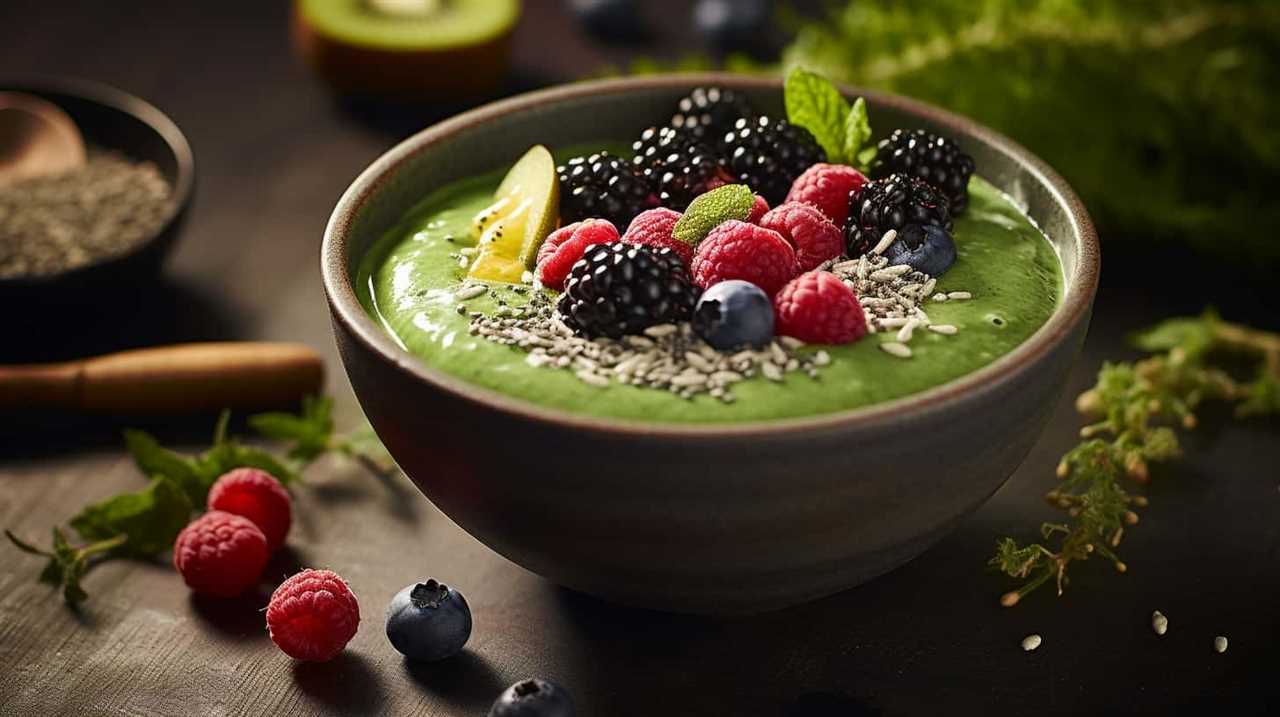
Is There a Recommended Dosage or Amount of Matcha to Consume for Optimal Energy Benefits?
For optimal energy benefits, it’s recommended to consume a moderate amount of matcha. Too little may not provide the desired boost, while too much can lead to jitters. Finding the right dosage is key.
Can Matcha Be Consumed at Any Time of the Day, or Is It More Effective for Energy in the Morning or Afternoon?
Matcha consumption timing can impact its effects on focus and productivity. While matcha can be consumed at any time of the day, it is often more effective for energy in the morning or afternoon.
Conclusion
In conclusion, matcha has been shown to provide a natural and sustained energy boost. Its combination of caffeine and L-Theanine promotes alertness, focus, and overall vitality.
For example, Sarah, a busy mother of two, started incorporating matcha into her daily routine and noticed a significant increase in her energy levels throughout the day. She was able to keep up with her kids, tackle her to-do list, and still have energy left for her own personal interests.

Matcha truly has the power to energize and enhance our daily lives.
Justin is a seasoned author, coffee and tea enthusiast, and an essential member of the Cappuccino Oracle team. With a keen appreciation for the complexities of coffee, coffee alternatives, and tea, Justin has dedicated his professional career to exploring these realms and sharing his insights with readers worldwide.
Justin’s immersion in the world of coffee, coffee alternatives, and tea began at a young age, kindling a passion that extended beyond mere consumption. This love for these beverages led him to combine his talent for writing with his devotion to coffee and tea, bringing him to Cappuccino Oracle as a dedicated author.
Matcha
Unveiling The Mysteries Of Matcha: Insights On Its Origins, Production, And Quality

Have you ever been curious about the mysteries behind the rich and natural flavors of matcha? If so, get ready to join me on an adventure as we uncover the secrets of matcha, delving into its origins, production, and quality.
As a lover of all things tea, I have delved deep into the world of matcha, immersing myself in its rich history and intricate production process. From the shade-grown tea leaves to the meticulous grinding technique, every step is a labor of love that culminates in the velvety smooth powder we know as matcha.
Join me as we unravel the secrets behind this ancient Japanese tradition and discover why quality is key when indulging in this verdant elixir. We’ll explore the nuances of flavor, the importance of sourcing, and even delve into the fascinating world of other tea varieties.
So grab a cup, sit back, and let’s dive into the captivating world of matcha.
Key Takeaways
- Matcha tea is made from powdered green tea leaves and has a long and labor-intensive production process.
- Premium matcha is made from the first harvest in early spring, using the top 3 sprouts of the tea plant and ground tencha leaves.
- Cheaper matchas may skip some steps in the production process and are more suitable for matcha lattes.
- High-quality matcha is recommended for sparing consumption, as it has a smoother flavor and more health benefits compared to cheaper matchas.
What is matcha?
I’ve learned that matcha is a powdered green tea made from special tea leaves that are shaded before harvest, and it has a long and labor-intensive production process.
There are different types of matcha available, but the premium matcha is made from the first harvest in early spring, using only the top 3 sprouts of the tea plant. The leaves are then steamed, dried, and have their stems removed before being ground into a fine powder using a specialized mill made of granite.
It’s important to note that high-quality matcha is recommended for sparing consumption, as it has a complex production process that results in a smooth flavor. Matcha also offers various health benefits, such as being rich in antioxidants, boosting metabolism, and improving mental alertness.
Production process
The matcha production process involves shading the tea leaves before harvest and selecting the top three sprouts of the tea plant for premium matcha. Shading is a technique used to enhance the flavor and quality of the tea leaves. By covering the tea plants with shade, the leaves produce more chlorophyll and amino acids, resulting in a vibrant green color and a rich, umami taste.
After the shading period, only the top three sprouts of the tea plant are carefully handpicked for premium matcha. These selected leaves, known as tencha leaves, are then steamed, dried, and have their stems removed.
Finally, the tencha leaves are ground into a fine powder using a specialized granite mill. This process results in the smooth and concentrated matcha powder that we enjoy.
Quality and consumption
Let me tell you, indulging in high-quality matcha is like sipping a vibrant green elixir that awakens your taste buds and nourishes your body with its rich flavor and numerous health benefits. Matcha’s health benefits are truly remarkable. Packed with antioxidants, vitamins, and minerals, matcha is known to boost metabolism, enhance focus and concentration, and strengthen the immune system.
But not all matcha is created equal. Different grades of matcha exist, ranging from ceremonial grade to culinary grade. Ceremonial grade matcha is made from the highest quality tencha leaves and has a smooth, vibrant green color and a delicate, umami flavor. It is best enjoyed on its own, whisked with hot water.
On the other hand, culinary grade matcha is more affordable and is suitable for making matcha lattes, smoothies, and baked goods. Although it may have a slightly bitter taste and a duller color, it still provides health benefits.
So, whether you choose to indulge in high-quality ceremonial grade matcha or opt for the more affordable culinary grade, incorporating matcha into your routine is a delicious way to reap its health benefits.
Frequently Asked Questions
What are some popular ways to enjoy matcha besides drinking it as tea?
Besides drinking matcha as tea, some popular ways to enjoy it include indulging in matcha desserts like matcha ice cream, matcha cake, and matcha cookies. Additionally, matcha smoothies are a refreshing and healthy option.
Are there any specific health benefits associated with consuming matcha?
I’m no expert, but matcha is said to have potential health benefits. Some claim it can aid in weight loss due to its high antioxidant content and metabolism-boosting properties. However, more research is needed to confirm these claims.
How does the quality of matcha affect its flavor and overall experience?
The quality of matcha directly affects its flavor and overall experience. Higher quality matcha, made from carefully selected leaves and processed with precision, offers a smoother and more vibrant flavor, while lower quality matcha may have a less appealing taste and color.
Can matcha be used in cooking or baking?
"Where there’s matcha, there’s a way! Matcha can be used in a variety of cooking and baking recipes, adding a vibrant green color and a unique earthy flavor to dishes like matcha desserts."
Are there any specific tips or techniques for properly preparing matcha tea at home?
To properly prepare matcha tea at home, start by sifting the matcha powder to remove any clumps. Then, choose water at around 175°F to 180°F for the best flavor. Gradually add water to the matcha and whisk in a "W" or "M" motion until frothy. Enjoy!
Conclusion
In conclusion, matcha tea is not just a beverage, but a rich and fascinating tradition that has evolved over centuries.
From its origins in Japan to its intricate production process, matcha is a labor of love.
The quality of matcha is crucial, as the steps taken in its production directly impact its flavor and aroma.
Whether you’re a matcha connoisseur or a beginner, there is a matcha tea out there for you.
So, why not indulge in a cup of this vibrant green elixir and experience the magic of matcha for yourself? It’s a journey worth embarking on!
Arf, an author and an innovative enthusiast of coffee, coffee alternatives, and tea, plays a crucial role as a contributor to the esteemed Cappuccino Oracle platform. Renowned for his curiosity and passion for these captivating beverages, Arf has carved out a unique space for himself in the world of exploration and writing. He realized that coffee, coffee alternatives, and tea are not mere drinks to keep one awake, but universes of flavors and stories waiting to be explored.
Arf’s articles for Cappuccino Oracle blend meticulous research with personal experiences, providing readers with an in-depth understanding of various types of coffee, coffee alternatives, and tea, along with their unique characteristics, cultures, and histories. His honest reviews and engaging narratives guide readers on their own journeys, helping them discover their preferences and find their perfect brew.
Matcha
Unveiling The Truth Behind Starbucks’ Matcha: A Disappointing Blend

Being a lover of tea, I was eager to sample Starbucks’ matcha beverages, anticipating a flavorful and genuine taste. However, to my dismay, I found that it was a subpar mixture of inexpensive green tea powder and an excessive amount of sugar. This was a stark contrast to the customary matcha experience that I had grown accustomed to.
The use of low-quality matcha by Starbucks is driven by the need for mass production and a consistent taste across all locations. But in this pursuit, they have sacrificed the true essence of matcha. Authentic matcha production involves meticulous steps to ensure a high-quality and flavorful product, steps that Starbucks seems to skip.
The result is a matcha latte packed with 32 grams of sugar, equivalent to a can of soda, and a whopping 240 calories. It’s time to unveil the truth behind Starbucks’ matcha and explore better options for a truly satisfying tea experience.
Key Takeaways
- Starbucks uses a cheap green tea powder for their matcha drinks, which may not even be considered matcha.
- The cheap matcha powder is mixed with a lot of sugar, negating the health benefits and undermining the quality of the tea.
- Starbucks’ matcha latte contains a high amount of sugar, similar to a can of soda, and has a significant number of calories.
- To have a better matcha experience, it is recommended to explore premium, first harvest matcha made by talented farmers in Japan and to try different matcha options to find preferred taste.
What is Starbucks Matcha?
Starbucks Matcha is a cheap green tea powder mixed with a high amount of sugar, which not only undermines the health benefits of matcha but also fails to deliver the natural, great-tasting flavor of authentic matcha tea.
The ingredients used in Starbucks matcha include low-quality green tea powder that is likely produced on a large scale. Unlike traditional matcha production methods, Starbucks skips certain steps to save time and money. These steps, such as shading the tea plants to reduce bitterness and selecting the top leaves for their flavor and nutrients, are crucial in creating high-quality matcha.
Instead, Starbucks opts for a blend of cheap green tea powder mixed with sugar, resulting in a dull and bitter flavor. This disappointing blend of ingredients does not live up to the standards of true matcha tea.
Quality vs. Cheap Matcha
Indulging in high-quality matcha is like savoring a delicate melody that dances on your taste buds, while settling for cheap matcha is akin to a discordant symphony that leaves a bitter aftertaste. When it comes to matcha, quality matters. Traditional matcha production is an art that requires time, patience, and attention to detail. The importance of shading the tea plants, selecting the top leaves, and using a stone mill to grind the leaves into a fine powder cannot be overstated. These steps not only enhance the flavor but also preserve the health benefits of matcha. High-quality matcha is rich in antioxidants, boosts metabolism, and promotes a sense of calm. On the other hand, cheap matcha often lacks these qualities as it skips crucial steps and is mixed with sugar and other additives. Don’t settle for a subpar matcha experience; choose high-quality matcha for its exceptional taste and health benefits.
| Traditional Matcha Production |
|---|
| Shading the tea plants |
| Selecting the top leaves |
| Grinding with a stone mill |
The importance of traditional matcha production cannot be overstated. These steps not only enhance the flavor but also preserve the health benefits of matcha. High-quality matcha is rich in antioxidants, boosts metabolism, and promotes a sense of calm. On the other hand, cheap matcha often lacks these qualities as it skips crucial steps and is mixed with sugar and other additives. Don’t settle for a subpar matcha experience; choose high-quality matcha for its exceptional taste and health benefits.
Recommendations for Better Matcha
Exploring different matcha options can lead to a better matcha experience. When it comes to matcha, not all options are created equal. While Starbucks may offer a convenient matcha latte, there are alternative options that provide a more authentic and higher quality experience.
Premium matcha, specifically first harvest matcha, is made by talented farmers in Japan and can be enjoyed plain, without the need for excessive sugar or additives. By choosing premium matcha, you can reap the full benefits that matcha has to offer, such as its high antioxidant content and potential health benefits.
Additionally, exploring different types of matcha, such as Japanese black tea, can expand your taste palate and introduce you to new and exciting flavors. So, why settle for a disappointing blend when there are better matcha options out there waiting to be explored?
Frequently Asked Questions
How is Starbucks matcha different from traditional matcha?
Starbucks matcha differs from traditional matcha in terms of quality and taste. One interesting statistic is that Starbucks’ matcha latte contains 32 grams of sugar, similar to a can of soda, which undermines the health benefits of matcha.
What are the health benefits of matcha and how do they differ between Starbucks matcha and premium matcha?
The health benefits of matcha include high levels of antioxidants, increased energy, and improved focus. However, Starbucks matcha quality is compromised due to the use of cheap powder mixed with sugar, negating these benefits.
Can you customize the sweetness level of Starbucks matcha drinks?
Yes, you can customize the sweetness level of Starbucks matcha drinks. They offer popular matcha drink variations like matcha latte and matcha frappuccino, allowing customers to choose the amount of sweetener they prefer.
Are there any alternative options for matcha drinks at Starbucks?
Yes, there are alternative options for matcha drinks at Starbucks. However, it’s important to note that the taste may not be comparable to traditional matcha. Exploring different matcha options and Japanese black tea can provide a better experience.
What are the steps involved in producing high-quality matcha and how does Starbucks’ matcha production differ?
Starbucks’ matcha production process differs from traditional matcha production in Japan. High-quality matcha involves shading the tea plants, selecting the top leaves, steaming, drying, and grinding them. However, Starbucks skips these steps, resulting in a lower quality and less authentic matcha experience.
Conclusion
In conclusion, after delving into the truth behind Starbucks’ matcha, it’s clear that their blend falls short of expectations. The use of cheap green tea powder mixed with excessive sugar dilutes any potential health benefits and fails to deliver an authentic matcha experience.
To truly enjoy the rich and flavorful taste of matcha, it’s recommended to explore premium, first harvest options crafted by skilled Japanese farmers. Don’t settle for subpar matcha; treat yourself to a tea experience that’ll leave your taste buds dancing with delight.
Arf, an author and an innovative enthusiast of coffee, coffee alternatives, and tea, plays a crucial role as a contributor to the esteemed Cappuccino Oracle platform. Renowned for his curiosity and passion for these captivating beverages, Arf has carved out a unique space for himself in the world of exploration and writing. He realized that coffee, coffee alternatives, and tea are not mere drinks to keep one awake, but universes of flavors and stories waiting to be explored.
Arf’s articles for Cappuccino Oracle blend meticulous research with personal experiences, providing readers with an in-depth understanding of various types of coffee, coffee alternatives, and tea, along with their unique characteristics, cultures, and histories. His honest reviews and engaging narratives guide readers on their own journeys, helping them discover their preferences and find their perfect brew.
Matcha
The Ultimate Guide To Using Chashaku: Your Matcha Essential

Being a lover of matcha, I am aware that the crucial factor in achieving the perfect matcha bowl is the equipment we utilize. When it comes to preparing matcha, there is one tool that is particularly essential: the chashaku.
This bamboo spoon, with its elegant design and precise measurements, is the secret weapon of matcha lovers worldwide. In this ultimate guide, I will take you on a journey through the history and evolution of the chashaku, and show you how to use it like a pro.
From its origins as a metal or ivory scoop to its modern-day incarnation in bamboo, the chashaku has come a long way. With its 48° bend and 18mm length, it effortlessly scoops the perfect amount of matcha from its container.
So grab your chashaku and get ready to elevate your matcha game to new heights. Let’s dive in and discover the wonders of this matcha essential.
Key Takeaways
- Chashaku is a bamboo spoon used to scoop matcha powder in the Japanese tea ceremony and by matcha lovers worldwide.
- Chashaku is one of the three important tea utensils used in the tea ceremony and is about 18mm in length with a 48° bend at the end for scooping.
- Chashaku is made of bamboo to avoid negative reactions with matcha powder and is a great measurement tool for matcha powder.
- Two scoops of chashaku is the standard amount for a bowl of matcha tea, and it is easy to maneuver in matcha tins or natsume due to its small size.
What is Chashaku?
Chashaku is a bamboo spoon used to scoop matcha powder, and it’s one of the three important tea utensils used in the Japanese tea ceremony.
Made from a single piece of bamboo, this elegant tool has a long history dating back to the Muromachi period in Japan. Originally crafted from metal or ivory, chashaku evolved to be made of bamboo due to its natural properties and to avoid any negative reactions with matcha powder.
The design of chashaku is both functional and beautiful, with a length of about 18mm and a 48° bend at the end for easy scooping. There are different styles of chashaku scoops, each with its own unique shape and characteristics. The back of the chashaku has a rough texture, while the face is smooth and sleek.
Whether you’re a matcha lover or a tea ceremony enthusiast, using a chashaku adds a touch of authenticity and tradition to your matcha preparation.
History and Evolution
During the Muromachi period in Japan, the chashaku spoon evolved from being made of metal or ivory to its current bamboo form, which is about 18mm in length and has a 48° bend at the end for easier scooping. The history and evolution of the chashaku is a testament to its significance in Japanese tea ceremonies and its cultural importance in matcha preparation.
| The significance of chashaku in Japanese tea ceremonies | The cultural importance of chashaku in matcha preparation |
|---|---|
| Chashaku is one of the three important tea utensils used in the tea ceremony. | Chashaku is a great measurement tool for matcha powder. |
| Chashaku originated in Japan during the Muromachi period. | Chashaku’s small size allows for easy maneuvering in matcha tins or natsume. |
| Originally made of metal or ivory, chashaku evolved to be made of bamboo. | Chashaku is made from a single piece of bamboo and shaped with a bend for the scoop. |
| Chashaku is made of bamboo to avoid negative reactions with matcha powder. | The back of chashaku has a rough texture, while the face is smooth and sleek. |
The chashaku’s role in Japanese tea ceremonies cannot be understated. It is one of the three essential utensils used in the tea ceremony, alongside the chawan (tea bowl) and chasen (tea whisk). The chashaku’s small size and precise measurement make it the perfect tool for scooping matcha powder. Its evolution from metal or ivory to bamboo shows the cultural importance placed on this utensil. The chashaku’s design, with its gentle bend and smooth face, allows for easy and graceful scooping of matcha. Using the chashaku is not only practical but also a way to honor the centuries-old tradition of matcha preparation.
How to Use Chashaku
To use the chashaku, I simply hold it like a pencil and dip the scoop into the matcha container. Then, I carefully lift the chashaku scoop out and place it over the matcha bowl to dump the powder.
It’s a simple and elegant technique that ensures the perfect amount of matcha every time.
But did you know that there are alternative ways to use the chashaku? Some matcha lovers prefer to use a teaspoon or a regular spoon to scoop their matcha powder. While these alternatives may work in a pinch, they don’t offer the same precision and authenticity as the chashaku.
The chashaku’s unique design and size make it the ideal tool for measuring matcha powder. Plus, using the chashaku adds a traditional touch to the matcha preparation process, enhancing the overall experience.
So why settle for anything less? Embrace the chashaku and elevate your matcha game to the next level.
Frequently Asked Questions
What are the different types of materials used to make chashaku besides bamboo?
There’s something truly magical about the chashaku, the bamboo spoon that gracefully scoops matcha powder. While bamboo is the traditional material, chashaku can also be made from metal or ivory, although these alternatives are less common.
Can chashaku be used to scoop other powders besides matcha?
Yes, chashaku can be used to scoop other powders besides matcha. However, it is primarily designed for scooping matcha powder and is most commonly used in Japanese tea ceremonies. To properly clean and care for a chashaku, it is recommended to wipe it with a dry towel or tissue to avoid water damage. The chashaku is a versatile tool with different uses in the tea ceremony, making it an essential item for matcha lovers.
How long does a chashaku typically last before it needs to be replaced?
A chashaku typically lasts for a long time, but the lifespan can vary depending on the material. Bamboo chashaku is the most common and durable option, while metal or ivory may wear down over time. Proper care involves cleaning with a dry towel or tissue to avoid water damage.
Can chashaku be used with different types of matcha bowls or is it specific to a certain style?
Absolutely! Chashaku can be used with various types of matcha bowls, adapting to different styles. Its small size and unique design make it perfect for scooping matcha powder and adding a touch of elegance to your matcha preparation.
Are there any alternative utensils that can be used in place of chashaku for scooping matcha powder?
Yes, there are alternative utensils for scooping matcha powder, such as a teaspoon or a small spoon. However, using a chashaku has its benefits. Its unique design allows for precise measurements and easy maneuvering in matcha tins.
Conclusion
In conclusion, using chashaku isn’t just a practical way to measure and scoop matcha powder, but it’s also an essential tool for embracing the art and tradition of the Japanese tea ceremony.
While some may argue that using a regular spoon can achieve the same result, chashaku offers a unique experience that connects us to centuries of tea culture. Imagine holding the slender bamboo spoon, feeling the weight of tradition in your hand, and delicately scooping the vibrant green matcha powder.
It’s a sensory journey that brings us closer to the beauty and mindfulness of matcha preparation. So, embrace the chashaku, and let it elevate your matcha experience to new heights.
Arf, an author and an innovative enthusiast of coffee, coffee alternatives, and tea, plays a crucial role as a contributor to the esteemed Cappuccino Oracle platform. Renowned for his curiosity and passion for these captivating beverages, Arf has carved out a unique space for himself in the world of exploration and writing. He realized that coffee, coffee alternatives, and tea are not mere drinks to keep one awake, but universes of flavors and stories waiting to be explored.
Arf’s articles for Cappuccino Oracle blend meticulous research with personal experiences, providing readers with an in-depth understanding of various types of coffee, coffee alternatives, and tea, along with their unique characteristics, cultures, and histories. His honest reviews and engaging narratives guide readers on their own journeys, helping them discover their preferences and find their perfect brew.
-

 Mushroom Coffee2 weeks ago
Mushroom Coffee2 weeks agoYour Ultimate Guide to Ryze Mushroom Coffee: 9 Things to Know
-

 Mushroom Coffee2 weeks ago
Mushroom Coffee2 weeks agoUnveiling the Puzzle: Top 10 Alternatives to Ryze Mushroom Coffee Revealed
-

 Mushroom Coffee2 weeks ago
Mushroom Coffee2 weeks agoUnveiling the Mysteries of Ryze Mushroom Coffee: Top 10 Questions Answered
-

 Mushroom Coffee2 weeks ago
Mushroom Coffee2 weeks ago3 Best Techniques to Brew Ryze Mushroom Coffee
-

 Coffee Basics3 weeks ago
Coffee Basics3 weeks agoHow Do Starbucks’ Seasonal Specialties Appeal to Customers?
-

 Rooibos2 weeks ago
Rooibos2 weeks ago9 Essential Steps to Perfect Rooibos Tea: A Brewing Guide
-

 Turmeric Tea1 week ago
Turmeric Tea1 week agoTurmeric Ginger, Cinnamon, Lemon, Honey Tea Benefits
-

 Mushroom Coffee2 weeks ago
Mushroom Coffee2 weeks agoIs Ryze Mushroom Coffee’s Caffeine Content More like Decaf or Regular Coffee?








